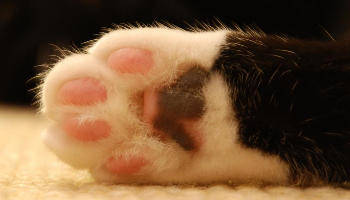Anatomy of a Paw
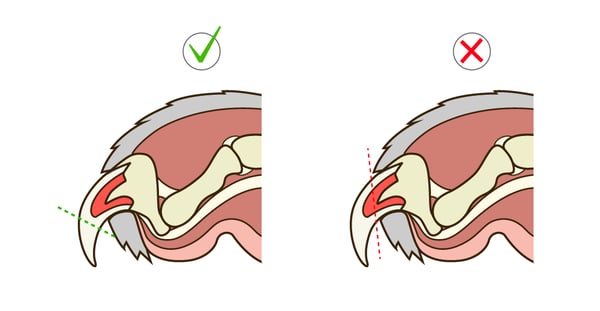 Before you start trimming, it’s best to get familiarized with the anatomy of your cat’s paw to ensure the process is both safe and painless.
Before you start trimming, it’s best to get familiarized with the anatomy of your cat’s paw to ensure the process is both safe and painless.
Cat nails, which are made up of a protein called keratin, grow directly out of their phalanges muscle. And, just like with any muscle, the phalanges are connected to nerves and blood vessels. These particular nerves and vessels reside in the pink section of your cat’s claw. This pink section, called the quick, should be avoided. Cutting past the white tip of the nail and into this area can cause extreme pain and bleeding for your cat. Keeping some styptic powder on hand to help stop bleeding can be beneficial if the quick is accidentally cut.
Most cats have 18 claws (5 on each front paw and 4 on each back).
Picking Your Clippers
There are four main types of claw clippers that can be used for trimming:
1. Scissor Style Nail Trimmers
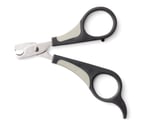
Scissor style. These look like a pair of scissors but feature a notch that holds the claw steady while you snip. Their low-profile design makes it easy to trim safely.
This design is great for beginners.
2. Plier Style Nail Trimmers

Pliers style. These clippers are strong and have long, comfortable handles, making them easy to use. This style is typically a good choice for cats who have thick, heavy nails.
These are the most commonly used for both at-home and groomer nail trims.
3. Guillotine Style Nail Trimmer
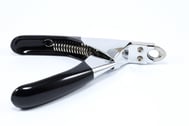 Guillotine style. These clippers feature a loop through which your cat’s claw passes and a blade that comes down to cut off the desired portion of the nail. Although these can be effective, they can become dull quickly, which can break, rather than cut the nail. This style can also make it more difficult to see where the quick of the nail begins.
Guillotine style. These clippers feature a loop through which your cat’s claw passes and a blade that comes down to cut off the desired portion of the nail. Although these can be effective, they can become dull quickly, which can break, rather than cut the nail. This style can also make it more difficult to see where the quick of the nail begins.
4. Electric Nail Grinder
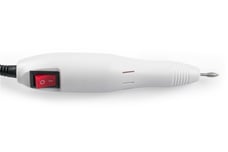
Electric grinder. Grinders are a quick and easy way to maintain your feline’s nails. A big pro is that they smooth edges that won’t need to be filed down later. A big con, however, is that the loud noise they can produce often scare cats away.
Choose the clippers that make you feel the most comfortable and always check to make sure the blades are sharp.
Introduce Your Cat to Nail Clipping
It’s always a good idea to let your kitty get accustomed to the idea of getting a manicure before you actually give it. Familiarizing them with the tools and the process at a young age will make for a much more accommodating feline. If your cat is already grown, don't worry! These tactics will still work, although it may take a few nail trims before they've adapted to the new approach.
1. Get your cat familiar with having their paws touched.
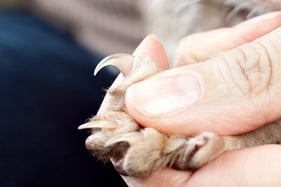 Take one of your cat's paws and gently massage it between your fingers for 2-3 seconds. If your cat pulls their paw away, don't grab it or squeeze. Simply follow their paw, gently touching their pads and in between their toes. This lets them adapt to the sensation of having their paws touched; something that many cats are not 100% comfortable with. After a few rounds, gently press their pads to extend their claws, then release immediately and offer them a treat. If your cat is especially defiant, do this routine a few minutes each day prior to the actual nail trim. This builds trust and the treats make this an activity that your cat will begin to look forward to participating in.
Take one of your cat's paws and gently massage it between your fingers for 2-3 seconds. If your cat pulls their paw away, don't grab it or squeeze. Simply follow their paw, gently touching their pads and in between their toes. This lets them adapt to the sensation of having their paws touched; something that many cats are not 100% comfortable with. After a few rounds, gently press their pads to extend their claws, then release immediately and offer them a treat. If your cat is especially defiant, do this routine a few minutes each day prior to the actual nail trim. This builds trust and the treats make this an activity that your cat will begin to look forward to participating in.
2. Get your cat familiar with the sound of the clippers.
The sound of the clippers can be scary for a cat, so let them become familiar with them a few days before you use them. To do so, use the clippers on a piece of dry spaghetti during your daily paw-rubbing session. While they are calmly sitting on your lap, gently press their pads to extend their nails and then clip a small piece off of the piece of spaghetti. Immediately release their paw and give them a treat. You can also allow your cat to sniff the nail clipper if they desire.
Making the Cut
 It’s important that you and your cat are calm when it’s time for a manicure. Start by always trimming nails in a quiet room, with no distractions, where you can comfortably set your kitty on your lap (if you have other pets, remove them from the room so that your kitty can relax and doesn't have to worry about what is going on around them).
It’s important that you and your cat are calm when it’s time for a manicure. Start by always trimming nails in a quiet room, with no distractions, where you can comfortably set your kitty on your lap (if you have other pets, remove them from the room so that your kitty can relax and doesn't have to worry about what is going on around them).
Place your cat on your lap facing away from you. Gently press their pad, check for the nail quick, and clip the white portion of the nail (it is better to take off too little than too much). After the first clip, take notice of how your cat responds. If they didn't seem to mind, continue to the next nail. If they appear bothered, immediately give them a treat.

If you can, continue trimming the remaining nails. Sometimes a cat will only allow one or two nails at a time, initially. If this is the case with your feline, just trim a nail or two each day until complete. Most cats will be comfortable at this point and, while they may not be thrilled about the idea, they will allow you to continue. Regardless, be sure to reward your kitty with treats and love once you are done with your session.
Maintaining Nail Trimmings
Most cats will need a nail trim every 2 weeks, so this is a good schedule to stick to. If you are unable to tell where your cat's quicks are, or if your kitty is just not having it, give us a call at Central Pet and schedule a bi-monthly nail trim. Our certified groomers are highly trained to handle even the most finicky of felines and can ensure that your kitty's nails are trimmed safely and stress-free.
Originally published in April 2017. Revised May 2019.


